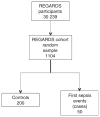Hemostasis biomarkers and risk of sepsis: the REGARDS cohort
- PMID: 27512924
- PMCID: PMC5503746
- DOI: 10.1111/jth.13446
Hemostasis biomarkers and risk of sepsis: the REGARDS cohort
Abstract
Essentials Few studies have investigated the risk of sepsis by baseline hemostasis biomarkers measures. Baseline hemostasis biomarkers and risk of sepsis was examined using case-control study design. Increased fibrinogen, factor IX, and factor XI levels may be associated with risk of sepsis. Hemostasis biomarkers may provide a target for sepsis mitigation or prevention.
Summary: Background Sepsis is a major public health concern, responsible for more than 750 000 hospitalizations and 200 000 annual deaths in the USA. Few studies have investigated the association between baseline measurements of hemostasis biomarkers and the future risk of sepsis. Objective To determine whether hemostasis biomarkers levels measured at baseline in a cohort of community-dwelling participants are associated with the risk of future sepsis events. Methods We performed a nested case-control study within the Reasons for Geographic and Racial Differences in Stroke (REGARDS) cohort. We identified sepsis hospitalizations occurring over a 10-year period. There were 50 incident sepsis cases with baseline measurements of hemostasis (fibrinogen, factor VIII, FIX, FXI, protein C, and D-dimer). Using incidence density sampling, we matched the 50 sepsis cases with 200 controls by age, sex, and race. We used conditional logistic regression to evaluate the association between baseline hemostasis biomarkers and future sepsis events. Results Comparison of 50 sepsis cases with 200 non-sepsis controls showed that sepsis cases had lower education and income, were more likely to live in the stroke belt, had chronic lung disease, and had higher albumin level/creatinine level ratios (ACRs). Individuals with higher baseline fibrinogen levels (adjusted odds ratio [OR] per standard deviation: 1.40, 95% confidence interval [CI] 1.01-1.94), FIX levels ([OR] 1.46, 95% [CI] 1.03-2.07) and FXI levels ([OR]1.52, 95% [CI] 1.04-2.23) were more likely to experience a sepsis event. Conclusion Baseline fibrinogen, FIX and FXI levels are associated with future episodes of sepsis. Hemostasis biomarkers may provide targets for sepsis mitigation or prevention.
Keywords: epidemiology; factor IX; factor VIII; factor XI; fibrinogen; sepsis.
© 2016 International Society on Thrombosis and Haemostasis.
Conflict of interest statement
M. M. Safford reports the following potential conflicts of interest: Amgen – salary support to study patterns of statin use in Medicare and other large databases; diaDexus – salary support for a research grant on lipids and CHD outcomes; diaDexus – consulting to help with an FDA application; and NIH, AHRQ – salary support for research grants. The other authors state that they have no conflict of interest.
Figures
Similar articles
-
Associations of coagulation factors IX and XI levels with incident coronary heart disease and ischemic stroke: the REGARDS study.J Thromb Haemost. 2017 Jun;15(6):1086-1094. doi: 10.1111/jth.13698. Epub 2017 May 9. J Thromb Haemost. 2017. PMID: 28393470 Free PMC article.
-
Hemostasis biomarkers and incident cognitive impairment: the REGARDS study.J Thromb Haemost. 2018 Jul;16(7):1259-1267. doi: 10.1111/jth.14138. Epub 2018 Jun 6. J Thromb Haemost. 2018. PMID: 29733497 Free PMC article.
-
Haemostasis biomarkers and risk of intracerebral haemorrhage in the REasons for Geographic and Racial Differences in Stroke Study.Thromb Haemost. 2017 Aug 30;117(9):1808-1815. doi: 10.1160/TH17-03-0189. Epub 2017 Jul 6. Thromb Haemost. 2017. PMID: 28692106 Free PMC article.
-
Coagulation factor XI as a novel target for antithrombotic treatment.J Thromb Haemost. 2010 Nov;8(11):2349-57. doi: 10.1111/j.1538-7836.2010.04031.x. J Thromb Haemost. 2010. PMID: 20727068 Review.
-
Quality assurance in hemostasis: the perspective from the College of American Pathologists proficiency testing program.Semin Thromb Hemost. 2007 Apr;33(3):250-8. doi: 10.1055/s-2007-971811. Semin Thromb Hemost. 2007. PMID: 17427059 Review.
Cited by
-
Pharmacokinetics of Vancomycin in Patients with Different Renal Function Levels.Open Med (Wars). 2018 Oct 22;13:512-519. doi: 10.1515/med-2018-0068. eCollection 2018. Open Med (Wars). 2018. PMID: 30426090 Free PMC article.
-
Risk factors for the development of sepsis in patients with cirrhosis in intensive care units.Clin Transl Sci. 2023 Oct;16(10):1748-1757. doi: 10.1111/cts.13549. Epub 2023 May 29. Clin Transl Sci. 2023. PMID: 37226657 Free PMC article.
-
Circulating Vitronectin Predicts Liver Injury and Mortality in Children With Sepsis: A Prospective Observational Study.Clin Appl Thromb Hemost. 2020 Jan-Dec;26:1076029620935201. doi: 10.1177/1076029620935201. Clin Appl Thromb Hemost. 2020. PMID: 32659109 Free PMC article.
-
Fibrinogen Is Associated with Prognosis of Critically Ill Patients with Sepsis: A Study Based on Cox Regression and Propensity Score Matching.Mediators Inflamm. 2023 Mar 20;2023:7312822. doi: 10.1155/2023/7312822. eCollection 2023. Mediators Inflamm. 2023. PMID: 36994229 Free PMC article.
-
Transcriptomics changes of calcitonin gene-related peptide in mitigating lipopolysaccharide-induced septic cardiomyopathy.Sci Rep. 2024 Nov 2;14(1):26385. doi: 10.1038/s41598-024-77520-5. Sci Rep. 2024. PMID: 39487252 Free PMC article.
References
-
- Angus DC, Linde-Zwirble WT, Lidicker J, Clermont G, Carcillo J, Pinsky MR. Epidemiology of severe sepsis in the United States: analysis of incidence, outcome, and associated costs of care. Crit Care Med. 2001;29:1303–10. - PubMed
-
- Angus DC. The lingering consequences of sepsis: a hidden public health disaster? JAMA. 2010;304:1833–4. - PubMed
-
- Dombrovskiy VY, Martin AA, Sunderram J, Paz HL. Occurrence and outcomes of sepsis: influence of race. Crit Care Med. 2007;35:763–8. - PubMed
-
- Martin GS, Mannino DM, Eaton S, Moss M. The epidemiology of sepsis in the United States from 1979 through 2000. N Engl J Med. 2003;348:1546–54. - PubMed
MeSH terms
Substances
Grants and funding
LinkOut - more resources
Full Text Sources
Other Literature Sources
Medical


